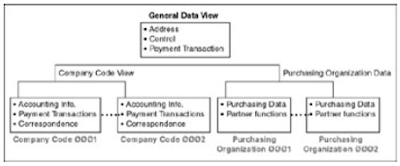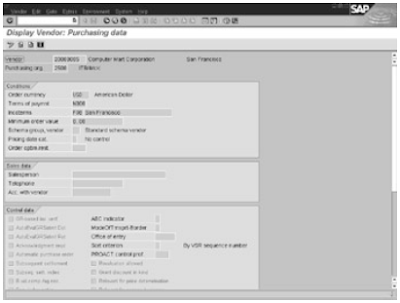At the core of ERP server system SAP will store master data and every ABAP programmer shall know about the basics of this master data.
The master data in the SAP system represents the characteristics of the business entities or the business objects used in the system, for example, material, customer, and vendor. These are stored in Material Master, Customer Master, and Vendor Master tables.
SAP also has organizational objects that represent the various organization entities. These entities have a defined business responsibility and are used to represent the company's structure in different forms, such as the purchasing organization, sales organization, and company code.
An organizational object and an SAP organizational object are bit different. Organizational objects are entities such as users, positions, and jobs. SAP organizational objects are company codes and sales organizations. They were named SAP organizational objects because of their relevance to the SAP system.
When master data is created in the system, we define views for each SAP organizational object, depending on the master data. For example, when you create a vendor, you create a separate view for each company code and purchasing organization that deals with the vendor,. A view holds information specific to the respective SAP organizational object.
Similarly, if you are creating a customer master, you have a separate view for each sales area, which consists of a sales organization, distribution channel, and division. For the material master, you have views that are based on plants, storage locations, sales organizations, and so on.
 You cannot create a purchase order for a vendor that has not been defined for your purchasing organization. You cannot order a material for a plant if the material has not been created for that plant and all this shall be done at the system level during the process of SAP project initiation.
You cannot create a purchase order for a vendor that has not been defined for your purchasing organization. You cannot order a material for a plant if the material has not been created for that plant and all this shall be done at the system level during the process of SAP project initiation.
Material Master Data for SAP:
A material master is created for materials you procure from a vendor. You must create a view for the plant to which the materials will be delivered. Although these are not EDI requirements, you cannot create a purchase order without this information.
Transaction code in SAP for this is MM01, MM02 and the Menu Path is Logistics, Materials Management, Material Master, Material, Create (general), Immediately .
Vendor Master Data for ERP SAP :
Transaction for this is XK01 and XK02 and the Menu Path: Logistics, Materials Management, Purchasing, Master Data, Vendor, Central, Create .
A vendor master is created for vendors from whom you procure material. Maintain the vendor for each purchasing organization that can procure from this vendor. The following fields must be entered in the vendor master for EDI in their respective views.
Purchasing Master data for EDI outbound process with message control :
Order Currency, Terms of Payment, and Incoterms must be filled. Incoterms define the commonly used trading terms established by the International Chambers of Commerce. If they are not filled, they need to be filled when creating a purchase order.
 SAP Purchasing Information Records:
SAP Purchasing Information Records:
The Transaction code for this ABAP screen is ME11 and Menu Path is Logistics, Materials Management, Purchasing, Master Data, Info Record, Create A vendor material information record contains vendor−specific information about a material.
For example, if you procure a particular material from three vendors, each vendor might call it a different name, the delivery times can be different, and the prices can vary. You store the vendor−specific information about a material in this table.
Figure below shows that material DPC1020 in your system is identified as VEN1000 at your vendor, Computer Mart Corporation. The fields in this table are required. You are not required to send the vendor's part number on an EDI transaction. It is the vendor's responsibility to convert the customer part number to the vendor's internal number.
 Related Posts:
Related Posts:
sap edi outbound process with message control for purchase introduction
And part two of edi outbound with message control for Purchase order
Cost center report for open line items of SAP
ERP Introduction
The master data in the SAP system represents the characteristics of the business entities or the business objects used in the system, for example, material, customer, and vendor. These are stored in Material Master, Customer Master, and Vendor Master tables.
SAP also has organizational objects that represent the various organization entities. These entities have a defined business responsibility and are used to represent the company's structure in different forms, such as the purchasing organization, sales organization, and company code.
An organizational object and an SAP organizational object are bit different. Organizational objects are entities such as users, positions, and jobs. SAP organizational objects are company codes and sales organizations. They were named SAP organizational objects because of their relevance to the SAP system.
When master data is created in the system, we define views for each SAP organizational object, depending on the master data. For example, when you create a vendor, you create a separate view for each company code and purchasing organization that deals with the vendor,. A view holds information specific to the respective SAP organizational object.
Similarly, if you are creating a customer master, you have a separate view for each sales area, which consists of a sales organization, distribution channel, and division. For the material master, you have views that are based on plants, storage locations, sales organizations, and so on.
 You cannot create a purchase order for a vendor that has not been defined for your purchasing organization. You cannot order a material for a plant if the material has not been created for that plant and all this shall be done at the system level during the process of SAP project initiation.
You cannot create a purchase order for a vendor that has not been defined for your purchasing organization. You cannot order a material for a plant if the material has not been created for that plant and all this shall be done at the system level during the process of SAP project initiation.Material Master Data for SAP:
A material master is created for materials you procure from a vendor. You must create a view for the plant to which the materials will be delivered. Although these are not EDI requirements, you cannot create a purchase order without this information.
Transaction code in SAP for this is MM01, MM02 and the Menu Path is Logistics, Materials Management, Material Master, Material, Create (general), Immediately .
Vendor Master Data for ERP SAP :
Transaction for this is XK01 and XK02 and the Menu Path: Logistics, Materials Management, Purchasing, Master Data, Vendor, Central, Create .
A vendor master is created for vendors from whom you procure material. Maintain the vendor for each purchasing organization that can procure from this vendor. The following fields must be entered in the vendor master for EDI in their respective views.
Purchasing Master data for EDI outbound process with message control :
Order Currency, Terms of Payment, and Incoterms must be filled. Incoterms define the commonly used trading terms established by the International Chambers of Commerce. If they are not filled, they need to be filled when creating a purchase order.
 SAP Purchasing Information Records:
SAP Purchasing Information Records:The Transaction code for this ABAP screen is ME11 and Menu Path is Logistics, Materials Management, Purchasing, Master Data, Info Record, Create A vendor material information record contains vendor−specific information about a material.
For example, if you procure a particular material from three vendors, each vendor might call it a different name, the delivery times can be different, and the prices can vary. You store the vendor−specific information about a material in this table.
Figure below shows that material DPC1020 in your system is identified as VEN1000 at your vendor, Computer Mart Corporation. The fields in this table are required. You are not required to send the vendor's part number on an EDI transaction. It is the vendor's responsibility to convert the customer part number to the vendor's internal number.
 Related Posts:
Related Posts:sap edi outbound process with message control for purchase introduction
And part two of edi outbound with message control for Purchase order
Cost center report for open line items of SAP
ERP Introduction
No comments :
Post a Comment